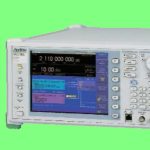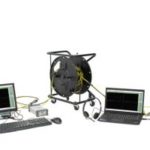When it comes to amplification, the principal parameters are gain and fidelity of the output relative to the input. Gain, denoted by β (Greek letter beta), is the ratio of output voltage, current or power to input. An amplifier by definition has a power gain greater than one. Measurements that characterize amplifier gain serve as […]
vector network analyzer
Handheld vector network analyzer works up to 26.5 GHz
The R&S ZNH is a full two-port handheld vector network analyzer up to 26.5 GHz with cable and antenna analysis and full S-parameter measurements. Both of these functions are included free of charge. The R&S ZNH is user-friendly, easy to configure and has a compact fanless housing for field applications. The R&S ZNH handheld vector […]
Measuring the behavior of electronic filters
Passive electronic filters are composed of one or more passive components including resistors, inductors and capacitors. In contrast, active electronic filters also contain an amplifier composed of transistors or op-amps. The point of electronic filters is to pass some frequencies while blocking others. Depending upon the configuration, they selectively attenuate high frequencies (low pass), low […]
Book Review: Create Your Own EMC Troubleshooting Kit
Create Your Own EMC Troubleshooting Kit (Volume 1): Essential Tools for EMC Troubleshooters by Kenneth Wyatt shows you the tools you need to start tackling interference problems. Tracking down and mitigating electrical interference isn’t black magic, though some would have you believe that. Armed with some knowledge on how signals travel and with the right […]
Basics of QAM reception and its measurement
A conventional AM broadcast generally begins in the studio as a music or voice audio signal. The audio signal modulates the amplitude of a radio-frequency electrical signal. This AM signal–also referred to as double-sideband amplitude modulation to distinguish it from single-sideband modulation–produces equal frequency sidebands on either side of the center frequency. In single-sideband modulation […]
Economical 7.5-GHz spectrum/VNA targets signal distortion, modulation, spectrum purity, frequency stability, crosstalk distortion parameters
The Siglent SVA1075X Spectrum/Vector Network Analyzer is a powerful tool with reliable automatic measurements for measuring the performance of RF circuits and networks such as amplifiers, filters, attenuators, cables, and antennas. With a wide frequency range from 9 kHz to 7.5 GHz, the SVA1015X analyzer delivers reliable automatic measurements with its built-in tracking generator and […]
VNA test cables sport flex life exceeding 100,000 cycles
A new series of highly flexible VNA test cables are designed to address a range of demanding test and lab applications. Fairview Microwave’s new high-frequency VNA test cables display excellent electrical properties such as exceptional phase stability of ±6° at 50 GHz and ±8° at 70 GHz, as well as VSWR of 1.3:1 at 50 […]
Two-port USB-controlled, lab-grade VNA operates from 300 kHz to 8.5 GHz
The Pico Technology PicoVNA 108 extends to 8.5 GHz the operating frequency range of the same-footprint PicoVNA 106 6 GHz instrument released three years ago. The new PicoVNA 108 fulfills user demand for “faster, more frequency range, more port power and dynamic range, and more functionality.” In addition to the PicoVNA 108’s extended range from […]
PC-based VNA handles signals out to 8.5 GHz
The newly announced PicoVNA 108 comes in the same low-cost, small-footprint and portable format as the widely used PicoVNA106 6 GHz instrument. The PicoVNA 108 can see out further to 8.5 GHz and it can see down deeper to –124 dB. It provides new “save on trigger” synchronization for multiple measurements, for example, with changing […]
Economical modular two-port VNAs work at up to 43.5 GHz
The ShockLine ME7868A family of modular two-port vector network analyzers (VNAs) can conduct full vector S-parameter measurements over wide distances of up to 100 m. Consisting of two MS46131A one-port VNAs with the PhaseLync synchronization option hardware and accessories, the ME7868A VNA uses the MS46131As as portable VNA ports to directly connect to the device […]










